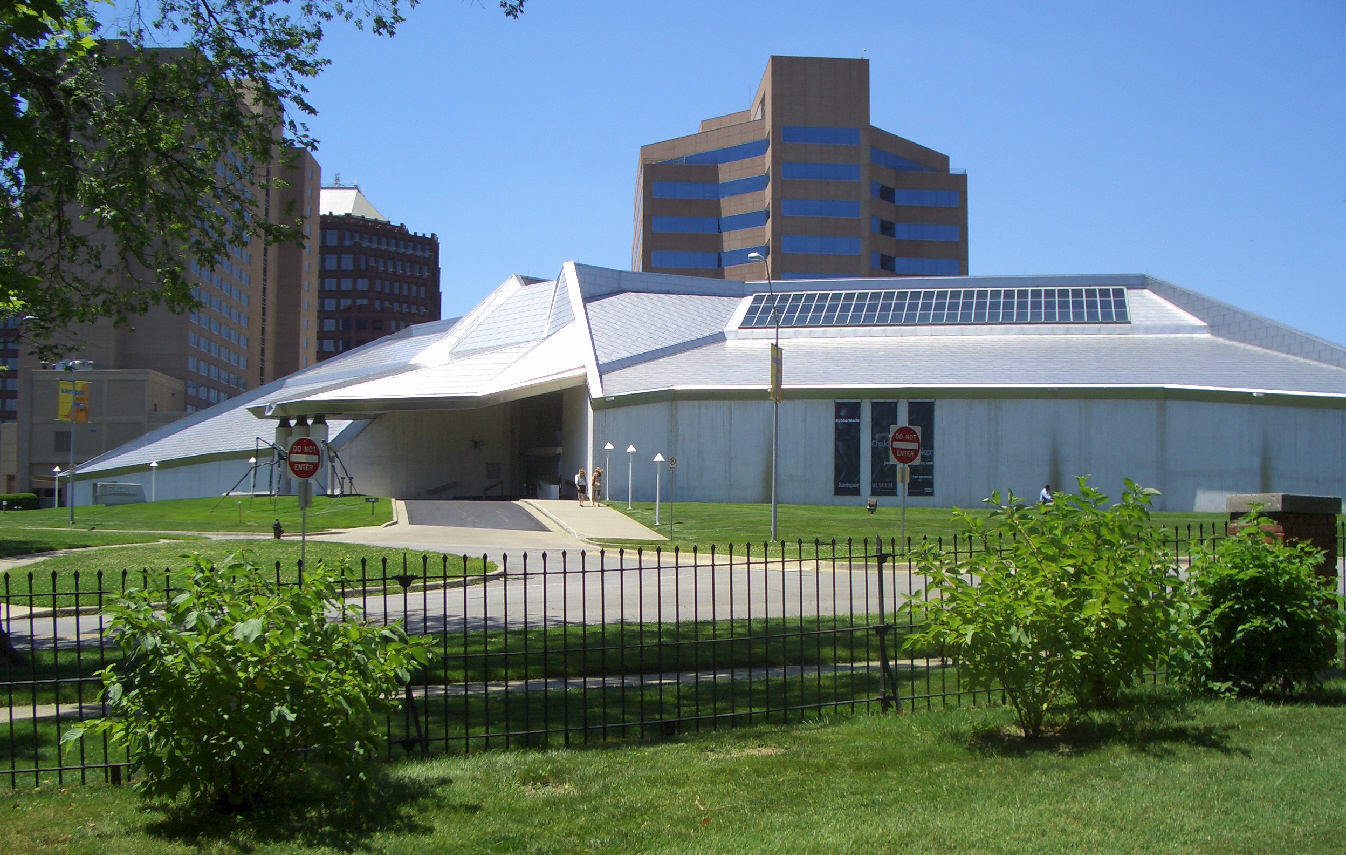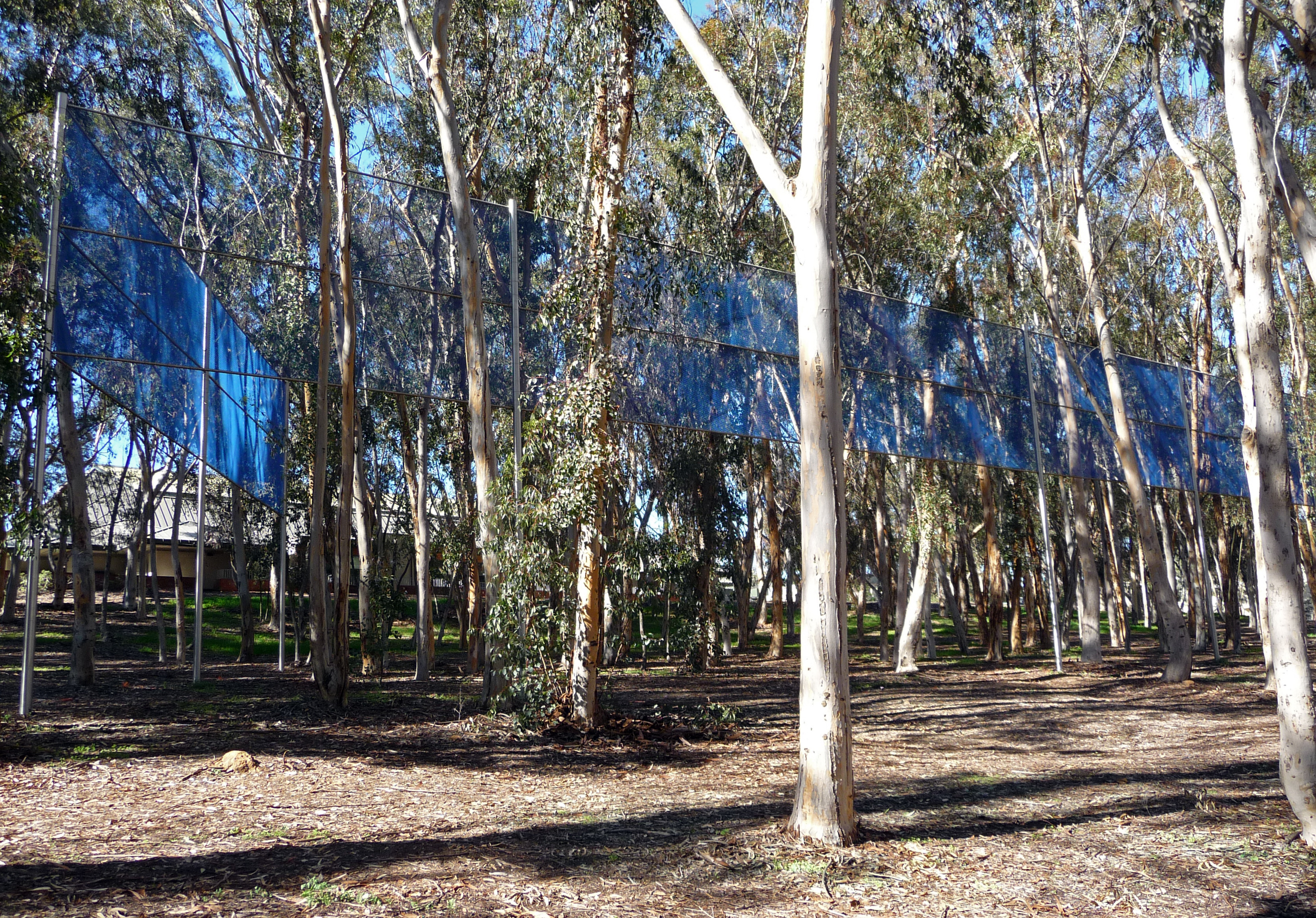|
Geisel Library
Geisel Library is the main library building of the University of California, San Diego. It is named in honor of Audrey and Theodor Seuss Geisel. Theodor is better known as children's author Dr. Seuss. The building's distinctive architecture, described as occupying "a fascinating nexus between brutalism and futurism", has resulted in its being featured in the UC San Diego logo and becoming the most recognizable building on campus. The library was designed by William Pereira and opened in 1970 as the Central Library. It was renovated in 1993 and rededicated as the University Library Building, and renamed Geisel Library in 1995. The UC San Diego Library consists of Geisel Library and the Biomedical Library Building, with off-campus locations at Scripps Archives and Library Annex, the Trade Street Storage Annex, and the UC Southern Regional Library Facility. Geisel Library is located in the center of the UC San Diego campus. It houses over 7 million volumes to support the educati ... [...More Info...] [...Related Items...] OR: [Wikipedia] [Google] [Baidu] |
Brutalist Architecture
Brutalist architecture is an architectural style that emerged during the 1950s in the United Kingdom, among the reconstruction projects of the post-war era. Brutalist buildings are characterised by minimalist constructions that showcase the bare building materials and structural elements over decorative design. The style commonly makes use of exposed, unpainted concrete or brick, angular geometric shapes and a predominantly monochrome colour palette; other materials, such as steel, timber, and glass, are also featured. Descending from the modernist movement, Brutalism is said to be a reaction against the nostalgia of architecture in the 1940s. Derived from the Swedish phrase ''nybrutalism,'' the term "New Brutalism" was first used by British architects Alison and Peter Smithson for their pioneering approach to design. The style was further popularised in a 1955 essay by architectural critic Reyner Banham, who also associated the movement with the French phrases '' béton bru ... [...More Info...] [...Related Items...] OR: [Wikipedia] [Google] [Baidu] |
Gunnar Birkerts
Gunnar Birkerts ( lv, Gunārs Birkerts, January 17, 1925 – August 15, 2017) was a Latvian American architect who, for most of his career, was based in the metropolitan area of Detroit, Michigan. Some of his notable designs include the Corning Museum of Glass and the Corning Fire Station in Corning, New York; Marquette Plaza in Minneapolis, Minnesota; the Kemper Museum of Contemporary Art in Kansas City, Missouri; and the U.S. Embassy in Caracas, Venezuela. In 2014, the National Library of Latvia in Riga was completed to his design. Biography Birkerts was born and raised in Latvia, but escaped ahead of the advancing Soviet army toward the end of the Second World War. He graduated from the Technische Hochschule, Stuttgart, Germany, in 1949. He acknowledged being influenced by Scandinavian tradition and the Finnish architect Alvar Aalto. Birkerts immigrated to the United States that year and worked initially for Perkins and Will, based in Chicago. He moved to the Detroit ... [...More Info...] [...Related Items...] OR: [Wikipedia] [Google] [Baidu] |
Paradise Lost
''Paradise Lost'' is an epic poem in blank verse by the 17th-century English poet John Milton (1608–1674). The first version, published in 1667, consists of ten books with over ten thousand lines of verse (poetry), verse. A second edition followed in 1674, arranged into twelve books (in the manner of Virgil's ''Aeneid'') with minor revisions throughout. It is considered to be Milton's masterpiece, and it helped solidify his reputation as one of the greatest English poets of all time. The poem concerns the The Bible, biblical story of the Fall of Man: the temptation of Adam and Eve by the fallen angel Satan and their expulsion from the Garden of Eden. Composition In his introduction to the Penguin Books, Penguin edition of ''Paradise Lost'', the Milton scholar John Leonard notes, "John Milton was nearly sixty when he published ''Paradise Lost'' in 1667. The biographer John Aubrey (1626–1697) tells us that the poem was begun in about 1658 and finished in about 1663. However, ... [...More Info...] [...Related Items...] OR: [Wikipedia] [Google] [Baidu] |
Alexis Smith (artist)
Alexis Smith (born Patti Anne Smith in Los Angeles, 1949) is an American artist. She has worked in collage and installation (art), installation. Biography Smith's father was a psychiatrist and she spent her childhood years living first on a citrus grove in Covina, California and then on the grounds of a mental hospital. "It was just off enough to be affecting," she later stated, "it had that edge of nonreality, of literal craziness". As a girl Smith created collages by cutting up and combining words and images. It was only later that friends encouraged her to take art classes. She studied with Vija Celmins and Robert Irwin (artist), Robert Irwin at UC Irvine, receiving her B.A. in 1970. In college, she impulsively changed her name to Alexis Smith, the name of the Hollywood actress of the 1940s and 1950s, and who won a Tony award in the 1970s. She is married to artist Scott Grieger. Artistic Style Since the 1970s, Smith has produced collages, artist's books, and gallery instal ... [...More Info...] [...Related Items...] OR: [Wikipedia] [Google] [Baidu] |
Snake Path, UCSD
Snakes are elongated, limbless, carnivorous reptiles of the suborder Serpentes . Like all other squamates, snakes are ectothermic, amniote vertebrates covered in overlapping scales. Many species of snakes have skulls with several more joints than their lizard ancestors, enabling them to swallow prey much larger than their heads (cranial kinesis). To accommodate their narrow bodies, snakes' paired organs (such as kidneys) appear one in front of the other instead of side by side, and most have only one functional lung. Some species retain a pelvic girdle with a pair of vestigial claws on either side of the cloaca. Lizards have evolved elongate bodies without limbs or with greatly reduced limbs about twenty-five times independently via convergent evolution, leading to many lineages of legless lizards. These resemble snakes, but several common groups of legless lizards have eyelids and external ears, which snakes lack, although this rule is not universal (see Amphisbaenia, ... [...More Info...] [...Related Items...] OR: [Wikipedia] [Google] [Baidu] |
The Cat In The Hat
''The Cat in the Hat'' is a 1957 children's book written and illustrated by the American author Theodor Geisel, using the pen name Dr. Seuss. The story centers on a tall anthropomorphic cat who wears a red and white-striped top hat and a red bow tie. The Cat shows up at the house of Sally and her brother one rainy day when their mother is away. Despite the repeated objections of the children's fish, the Cat shows the children a few of his tricks in an attempt to entertain them. In the process, he and his companions, Thing One and Thing Two, wreck the house. As the children and the fish become more alarmed, the Cat produces a machine that he uses to clean everything up and disappears just before the children's mother comes home. Geisel created the book in response to a debate in the United States about literacy in early childhood and the ineffectiveness of traditional primers such as those featuring Dick and Jane. Geisel was asked to write a more entertaining primer by William Sp ... [...More Info...] [...Related Items...] OR: [Wikipedia] [Google] [Baidu] |
Stuart Collection
The Stuart Collection is a collection of public art on the campus of the University of California San Diego. Founded in 1981, the Stuart Collection's goal is to spread commissioned sculpture throughout the campus, including both traditional sculptures and site-specific works integrating with features of the campus such as landscaping and buildings. It is supported by the UCSD Department of Visual Arts, the National Endowment for the Arts, and many private organizations and individuals. The collection was conceived by and named after its initial benefactor, James Stuart DeSilva. Since its creation, it has been administered by Director Mary L. Beebe. It contains nineteen works, with numerous others planned that have not or never will come to fruition. The first work added to the collection was Niki de Saint Phalle's ''Sun God (statue), Sun God'', and the most recent addition is Mark Bradford's ''What Hath God Wrought?'' Installations References External links Stuart Collection W ... [...More Info...] [...Related Items...] OR: [Wikipedia] [Google] [Baidu] |
John Baldessari
John Anthony Baldessari (June 17, 1931 – January 2, 2020) was an American conceptual artist known for his work featuring found photography and appropriated images. He lived and worked in Santa Monica and Venice, California. Initially a painter, Baldessari began to incorporate texts and photography into his canvases in the mid-1960s. In 1970 he began working in printmaking, film, video, installation, sculpture and photography.John Baldessari MoMA Collection. He created thousands of works which demonstrate—and, in many cases, combine—the narrative potential of s and the associative power of |
Hillcrest Medical Center
Hillcrest may refer to: Places Australia *Hillcrest, Queensland, a suburb of Logan City * Hillcrest, South Australia, suburb of Adelaide *Hillcrest, Tasmania, suburb of Burnie Canada *Hillcrest, Alberta, also known as Hillcrest Mines *Hillcrest, Norfolk County, Ontario, an unincorporated community *Hillcrest, Prince Edward County, Ontario, an unincorporated community * Hillcrest, Toronto, Ontario, a neighbourhood Ireland * Hillcrest, Lucan Housing estate in Lucan, Co. Dublin Malaysia *Sekolah Menengah Kebangsaan Hillcrest, Batu Caves, Malaysia * Hillcrest Residence, Penang *Hillcrest Gardens, Puchong New Zealand *Hillcrest, Auckland, a suburb of Auckland *Hillcrest, Waikato, a suburb of Hamilton South Africa *Hillcrest, KwaZulu-Natal, a suburb of eThekwini in KwaZulu-Natal * Hillcrest, Pretoria, a suburb of Pretoria United States (by state then city) * Hillcrest, Little Rock, Arkansas, a neighborhood in Little Rock *Hillcrest, California (other) ** Hillcrest, Los ... [...More Info...] [...Related Items...] OR: [Wikipedia] [Google] [Baidu] |





